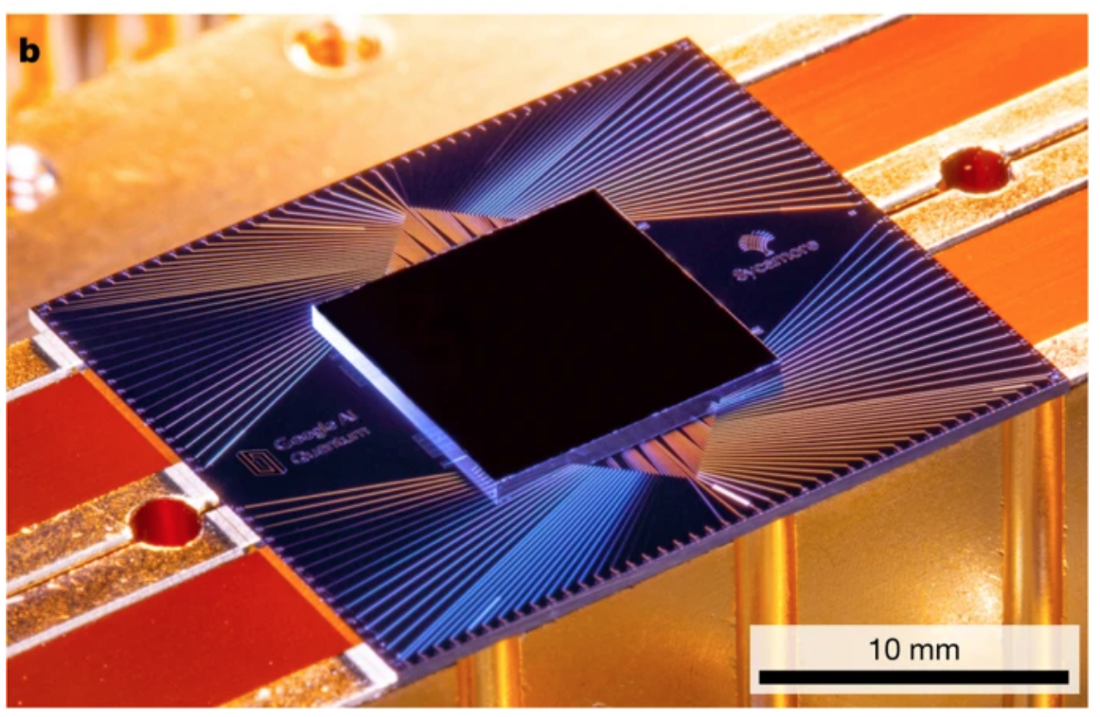The Google Sycamore chip, 54 qubits, capable of performing a calculation in 200 seconds that would take a classical computer 10,000 years to complete. This was the basis of Google’s quantum supremacy achievement which was widely hailed as a major milestone in the development of quantum computing and has spurred further research and development in the field.
What is Google Sycamore?
Google Sycamore is a quantum computer developed by Google AI Quantum. Google Sycamore chip is based on a type of quantum computing called superconducting qubits, which uses electric currents flowing through superconducting materials to store and process information.
Innovation of Google Sycamore
Google is known as one of the most innovative tech startups in history. From small beginnings as a Ph.D. research project (BackRub) by Larry Page and Sergey Brin at Stanford University in the mid-1990s to the global behemoth it is today, Google — or rather Alphabet Inc., Google’s holding company — dominates many areas of innovation such as its search engine (Google), advertising (AdSense), web-based services (Gmail/Google Earth), software (Chrome/Android mobile operating system), and hardware products (Chromebook/Chromecast). But where does sycamore quantum computing processor development fit?
Google Quantum AI Lab
Yet, this was clearly not enough for the Mountain View, California-based company. Established in 2013, The Quantum Artificial Intelligence Lab (also called the Quantum AI Lab or QuAIL) — a joint initiative of NASA, Universities Space Research Association, and Google (specifically, Google Research) and hosted at NASA’s Ames Research Center — has it as its long-term goal

to build scalable quantum computers that enable humankind to solve problems that would otherwise be impossible
In the nearly ten years since its founding, Google Quantum AI has achieved several key benchmarks in quantum computing, with the October 2019 announcement that it had achieved quantum supremacy undoubtedly taking the top spot in regard to significance.

But what is happening in 2022? How is Google Quantum AI differentiating itself from the competition? Led by Hartmut Neven, current Vice President of Engineering at Google and head of the Lab which he founded, Google Quantum AI offers software and hardware products, research capabilities and educational opportunities.
Google Quantum AI Software
Google Quantum AI’s software stack includes open-source tools and a quantum computing service to develop novel quantum algorithms. The programming framework is built upon Cirq, a Python software library for writing, manipulating, and optimizing quantum circuits. Specifically designed to help solve near-term applications for practical problems, Cirq “provides useful abstractions for dealing with today’s noisy intermediate-scale quantum computers, where details of the hardware are vital to achieving state-of-the-art results.”
Great features cover tutorials from those whose knowledge base is at the absolute minimum to quantum circuit simulation, designed for beginners — all the way down to quantum approximate optimization algorithm, designed for the more advanced users in mind.
What Makes Sycamore Processor Different?
When it comes to hardware, Google Quantum AI Lab has its quantum processor manufacturing facility. Over the last few years, it has developed Foxtail, Bristlecone, and most recently Sycamore chip, which is the superconducting transmon quantum processor “that took humanity beyond classical computations and boldly into the NISQ era.”
Foxtail, released in 2017, was a 22-qubit processor based on superconducting architecture. Made available in 2018, meanwhile, Bristlecone— like the Sycamore processor after it — was a superconducting transmon quantum device with 72 qubits.
Making its debut in 2019 with 53 ‘effective’ qubits, Sycamore was the processor that Google claimed to have achieved quantum supremacy in the very same year.
Other companies, now or in the past, have been or are focused on building superconducting transmon quantum computers, such as Rigetti Computing and Oxford Quantum Circuits (OQC), as well as the IBM and its Q50 prototype from 2017.
Sycamore Computer Achievements
Other achievements with the Sycamore quantum processor include the largest chemical simulation on a quantum computer — a Hartree–Fock approximation with Sycamore paired with a classical computer that analyzed results to provide new parameters for the 12-qubit system — in 2020; last year researchers working with Sycamore computer reported they were able to realize the ground state of the toric code, a topologically ordered state, with 31 qubits; and, also in 2021, a collaboration between Google and multiple universities reported the observation of a discrete-time crystal on the Sycamore processor.
Is Google Sycamore Quantum Computer Groundbreaking Innovation?
Along with IBM, Microsoft and others, Google Quantum AI is a leading player in full-stack capabilities in quantum computing. The Sycamore quantum processor — its several achievements so far proof of that — is set to break new ground as researchers and engineers globally explore the hard science of our industry.
This roadmap — discussed in a Google blog post in May 2021, Unveiling our new Quantum AI campus — spells out the Lab’s path:
To reach this goal, we’re on a journey to build 1,000,000 physical qubits that work in concert inside a room-sized error-corrected quantum computer. That’s a big leap from today’s modestly-sized systems of fewer than 100 qubits.
To get there, we must build the world’s first “quantum transistor” — two error-corrected “logical qubits” performing quantum operations together — and then figure out how to tile hundreds to thousands of them to form the error-corrected quantum computer. That will take years.
To get there, we need to show we can encode one logical qubit — with 1,000 physical qubits. Using quantum error correction, these physical qubits work together to form a long-lived nearly perfect qubit — a forever qubit that maintains coherence until power is removed, ushering in the digital era of quantum computing. Again, we expect years of concerted development to achieve this goal.
And to get THERE(!), we need to show that the more physical qubits participate in error correction, the more you can cut down on errors in the first place — this is a crucial step given how error-prone physical qubits are. We’re doing that research right now on our Quantum AI campus.
For more market insights, check out our latest quantum computing news here.

















